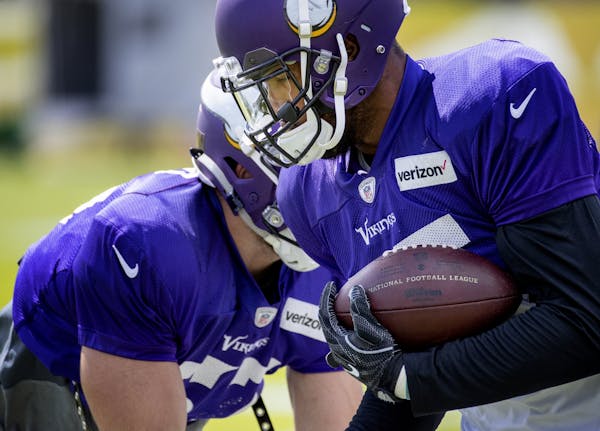The Vikings' 1997 season was a fascinating ride, one that saw the team start 8-2 to put itself in a three-team NFC Central race with the Buccaneers and the defending Super Bowl champion Packers. The Vikings lost five consecutive games after that, recovered to make the playoffs with a season-ending victory over the Colts and staged a fourth-quarter comeback in the Meadowlands to beat the Giants for their first playoff victory in a decade.
And for half the games the Vikings played in the Metrodome, nobody in the Twin Cities' TV market saw them.
The Vikings had four of their eight home games blacked out that year, when three of the first four failed to sell out before a league-imposed deadline to show the game on local TV. In Week 17, with a playoff spot on the line, the Vikings' victory over the Colts was blacked out.
It was a dreary time on the Twin Cities sports scene, with no NHL franchise, a Twins team that played insignificant games before scores of empty seats at the Metrodome and a Wolves club that was still a few months from the first playoff victory in team history. The Gophers men's basketball team had captivated the state earlier that year with its Final Four run, though that, too, was eventually to be tainted by scandal.
And then the calendar turned to 1998, the Vikings used the 21st pick in the draft on Randy Moss and everything changed.
My memories of what Moss did to the Minnesota sports scene that year, filtered through my mind's eye as a high school sophomore, are crystal clear 20 years later: purple jerseys dotting the hallways at Apple Valley High School in numbers that weren't there before, those "Purple Pride" flags that were clamped to cars everywhere you drove, the raucous atmosphere at the Metrodome that lived up to new owner Red McCombs' pledge to make it the "noisiest stadium in the NFL."
When Moss filleted the Packers on that rainy October night at Lambeau Field and roasted the Cowboys on Thanksgiving Day — turning the teams that had represented the NFC in five of the past six Super Bowls into stooges — Vikings fans swelled with pride. It was weeks before Super Bowl XXXIII when KDWB debuted its Vikings-themed parody of Will Smith's "Miami;" as much as the song and its timing belied the self-effacing (and often fatalistic) nature of Minnesota sports fans, nobody raised a fuss at the time. That team, that offense, and particularly Moss made Vikings fans that confident they would be in South Florida for the Super Bowl.
The Vikings lost the NFC Championship Game in overtime at home, of course, and would go 4-4 in the playoffs with Moss on the roster, but the electricity he delivered to the fan base never really faded, and in some ways it hasn't gone away since.
Despite a few close calls, the Vikings haven't had a game blacked out locally since 1997. They sold out 144 consecutive home games from 1998 to 2012, and in the time since drafting Moss — especially with fans my age, who've spent most of our years since then in advertisers' prized 18-to-34 demographic — the Vikings have lapped every other team in town for popularity. It might never have been in serious doubt who rules the sports landscape in the Twin Cities, but it certainly hasn't been a question since Moss came to town.
Would U.S. Bank Stadium exist without Moss? Perhaps — but the push for a new stadium began while he was still on the team. His exits from Minnesota — especially his second one in 2010 — were ugly, but this state hasn't parted on particularly good terms with many of its stars.
And while the excitement level surrounding the Vikings has reached its high points since Moss' rookie year (particularly with Brett Favre in 2009), I'd argue there's no team and no player that has captivated Minnesota quite like the 1998 Vikings and Moss.
Favre was a future Hall of Famer who arrived in Eden Prairie with a cinematic narrative; Adrian Peterson was a Heisman Trophy runner-up with a well-established pedigree. There was something fresh, something scintillating about Moss. He changed the way the entire league defended receivers; Mike Zimmer has told a story about how, when he was a defensive backs coach in Dallas preparing for Moss, he'd have receivers line up a yard offside to mimic how quickly his corners would have to react to Moss. He dominated in a way that almost seemed impossible, like Minnesota couldn't have it this good.
Despite the state's sad-sack view of its sports teams, Minnesotans my age have enjoyed their fair share of great moments. If we weren't quite old enough to remember the 1987 Twins, we certainly were old enough to be thrilled by the 1991 North Stars and Twins. We were in high school for Kevin Garnett, in college for the Wild's 2003 playoff run, the Gophers' two men's hockey titles and the beginning of Lindsay Whalen's storied career,
But for sheer exhilaration — in the 20 or so years of my youth, adolescence and young adulthood when sports matter the most — Moss left an imprint on Minnesotans my age that hasn't been matched, and quite possibly won't be again.
Braves' Travis d'Arnaud hits first 3 HRs of season, including go-ahead slam, in 8-3 win over Rangers

